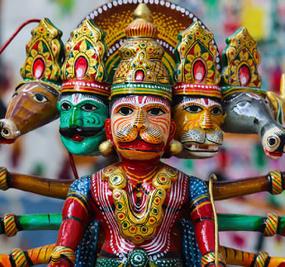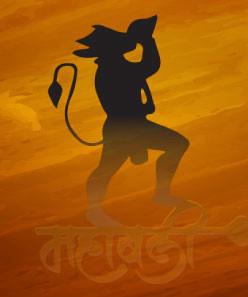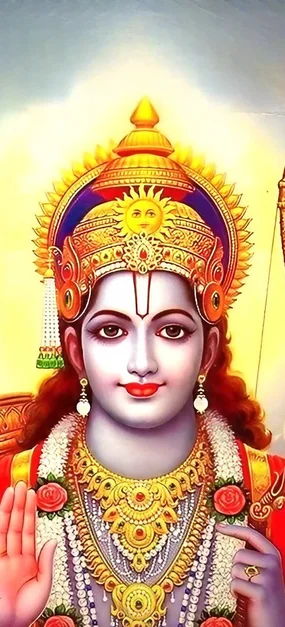Lord Hanuman, son of the Wind God, Vayu, is considered the greatest devotee of Lord Rama. His loyalty and devotion to the Lord are legendary. A Vedic scholar, he has a host of epithets –Anjaneya and Anjaniputra (son of Anjana, his mother), Maruti and Vayuputra (son of Marut (air) and Vayu (wind)), and Bajrangbali (one who is as strong as a diamond). This multifaceted and powerful god has devotees all over the world. We see a global spread of famous Hanuman temples, especially in India.
Let’s explore eight famous Hanuman temples in India.
1. Sankat Mochan Hanuman Temple
Location: Varanasi, Uttar Pradesh on the banks of the Assi River
History: It is believed to have been established in the 16th century by Sant Goswami Tulsidas, author of Ramcharitmanas.
Special features: Lord Hanuman can be seen facing Lord Rama in this temple
Legend: It is believed that Tulsidas had a vision of Lord Hanuman on this spot.

Interesting facts:
- Sankat mochan means ‘one who relieves us from troubles’.
- Besan laddoo (sweet balls made of gram flour) is the prasad or offering given in this temple.
- People worship Lord Hanuman in this temple to ward off the evil effects of the planets.
- Every year in April, Sankat Morchan Sangeet Samaroh, a classical music and dance concert is held here. Performers participate from all over India and even outside.
- An annual festival is celebrated here on the full moon night of the month of Chaitra.
2. Jakhu Temple
Location: On Jakhu hill, the highest peak of Shimla, in Himachal Pradesh
History: This temple is believed to date back to the time of the Ramayana – built after Lord Hanuman visited this spot during the Ramayana war.
Special features: A 108 feet idol of Hanuman was unveiled in 2010.
Legend: During the Ramayana war, while fighting the demon king Ravana’s army, Lord Rama’s brother, Lakshmana, was struck by an arrow and fell unconscious. Lord Hanuman set off on a quest to bring back sanjivani booti – herbs to revive Lakshmana. It is believed that Lord Hanuman took the rest on this mountain top during his search.

Interesting facts:
- An annual festival is celebrated during Dussehra here.
- A ropeway was constructed in 2017 which has made the temple more accessible to the public.
- From the hilltop, you get a magnificent view of the Shivalik mountain range.
- As if in reverence to the monkey god, Lord Hanuman, you will find colonies of monkeys waiting to greet you!
3. Mahavir Mandir
Location: Patna, Bihar
History: Swami Balanand, an ascetic, built this temple in 1730. During the partition of India in 1947, many refugees came to Patna, at which time this temple gained prominence. A concrete house was built here, which was replaced by a marble temple in 1987.
Special features: The temple has three levels:
- Ground floor – It has the idols of Lord Hanuman. One idol fulfills the wishes of devotees and another purifies their sins. There is also a place of worship for Lord Shiva here.
- The first floor – It houses the idols of Lord Rama, Lord Krishna, Lord Shiva, Goddess Parvati, and Nandi. It also has the Ramsetu Shila, a stone that is believed to have been part of the bridge built from India to help Lord Rama cross over to Lanka to rescue Sita.
- The second floor – Used for religious ceremonies

Interesting facts:
- It is the second most-visited religious shrine in North India after Vaishno Devi in Jammu and Kashmir.
- Every year, during Ram Navami, thousands of devotees queue up to visit this temple.
- It is known as Manokamna Temple, as it is believed that prayers offered with a pure heart will be fulfilled.
Paritala Anjaneya in Andhra Pradesh is the tallest statue of Lord Hanuman in the world.
The 135 feet tall statue was unveiled in 2003. Outside India, the Trinidad Hanuman Temple in Trinidad houses the largest Hanuman statue – it is 85 feet tall.
4. Bala Hanuman Temple (Also called Shri Balahanuman Sankirtan Mandir)
Location: Jamnagar, Gujarat on the south-east side of Ranmal or Lakhota Lake
History: Shri Prem Bhushanji Maharaj established this temple in 1963-64
Special features: The temple houses the idols of Lord Ram, Lord Lakshmana, Goddess Sita, and Lord Hanuman.

Interesting facts:
- Since August 1, 1964, chanting of ‘Sri Ram, Jai Ram, Jai Jai Ram’ has been going on continuously. Devotees have taken turns to chant night and day. It has been listed in the Guinness Book of World Records for this steadfast and resolute devotion.
- Khijadia Bird Sanctuary is a popular tourist spot near this temple.
5. Hanuman Mandir (Also called Bade Hanuman Ji Temple)
Location: Sangam (where rivers Ganga, Yamuna and Saraswati meet) area of Allahabad, Uttar Pradesh
History: It is believed to exist from the time of the Ramayana.
Special features: The Lord Hanuman statue is 20 feet long and 8 feet wide, is underground and in a reclining position, hence called ‘Lete (lying down) Hanuman’ Mandir. Half the idol is immersed in water. It is believed that the water of the river Ganga rises to touch the feet of the Lord Hanuman’s idol every year.
As the idol is so large, the temple is called Bade (big) Hanumanji Temple.

Legend:
- One legend says that after burning Lanka, Lord Hanuman rested here.
- Another legend says that a wealthy childless trader built this large structure of the Lord and bathed it at various pilgrimage sites. When at Prayag, Allahabad, he dreamt that his wishes would come true if he left the statue there. He did so and a son was born to him later.
Interesting facts:
- The Akbar/Allahabad Fort is a tourist attraction near this temple.
6. Namakkal Anjaneyar Temple
Location: Namakkal, Tamil Nadu
History: The temple and idols are believed to be in existence since the 5th century CE.
Special features: There is a pillared hall that leads up to the sanctum. This temple boasts of one of the tallest Hanuman statues in India – 18 feet tall facing the Narasimha shrine at the foothills.
Legend: It is said that Lord Vishnu’s consort, Goddess Lakshmi performed penance at this spot. Lord Hanuman had an image of Lord Vishnu made of saligrama (fossilized stone). Goddess Lakshmi expressed a wish to see Lord Vishnu in his Narasimha avatar. Lord Hanuman gave her the image to safeguard until he returned. Lakshmi placed the image at this spot and this grew into a mount before Lord Hanuman could return. It is said that Lord Vishnu appeared as Narasimha before both of them.

Interesting facts:
- Every year around March-April, in the Tamil month of Panguni, a 15-day festival, Panguni Uthiram is held. The image of all the deities is taken around the streets of the temple.
- The Narasimhaswamy Temple, located at the foothills, is also a place devotees visit.
7. Hanumangarhi
Location: Ayodhya, Uttar Pradesh
History: It is believed to have been built in the 10th century CE.
Special features: The temple is built like a fort with all four sides covered. In all four corners, there is a circular bastion that houses a temple of Lord Hanuman. The main temple houses an idol of Maa Anjana with Bal Hanuman sitting on her lap. 76 steps lead up to the temple.
Legend: It is believed that Lord Hanuman lived in a cave here and guarded Ramkot, the birthplace of Lord Rama.

Interesting facts:
- As Lord Hanuman is considered Lord Rama’s greatest devotee, it is only fitting that this temple is close to the hearts of devotees of Lord Rama. It is said that devotees must visit this temple before visiting Lord Rama’s temple. During Hanuman Jayanthi and Ram Navami, devotees throng to this temple praying for their wishes to come true.
8. Panchamukhi Hanuman Temple
Location: Rameshwaram, Tamil Nadu
History: It is believed to exist since the time of the Ramayana.
Special features: The face of the five-faced (Panchamukhi) idol of Lord Hanuman has the Lord in the middle (facing east) with Lord Narasimha (facing south), Lord Adivaraha (facing north), Lord Garuda (facing west) and Lord Hayagriva (facing the sky) on the sides. You will also find idols of Lord Rama and his consort Sita here.
Legend: During the Ramayana war, the demon king Ravana sought the help of another demon, Mahiravana or Mayil Ravana. This demon disguised himself as Vibheeshana (Lord Ravana’s brother who was on Lord Rama’s side) and tricked Lord Rama and his brother Lakshmana into going to patala loka to kill them.
It is said that to kill Mayil Ravana, Lord Hanuman had to extinguish five lamps (some legends say five wasps) all at once. Lord Hanuman assumed the Panchmukhi Hanuman form to accomplish this. It is believed that the location of this temple is the place where he revealed this form.

Interesting facts:
- Floating stones believed to have been used to build the legendary Ram Sethu Bridge are kept at this temple.
- It is situated 2 km from the Sri Ramanathaswamy Temple.
- It is believed that devotees pray to
- Lord Narasimha to get rid of their enemies
- Lord Garuda to overcome the bad effects of planets
- Lord Varaha for wealth
- Lord Hayagriva for gnana (enlightenment)
Lord Hanuman for washing off sins and attaining purity of mind
While Lord Hanuman resides in the hearts of all his devotees, these famous Hanuman temples are on the bucket list of places to visit for devotees of the unassuming Lord. Which is your favorite Hanuman temple? Tell us where your meditation is and prayer is strongest.
Featured Articles
- Temples of Lord Shiva- Pancha Bhoota Sthalam
- Ashtavinayak Temples in Maharashtra


















